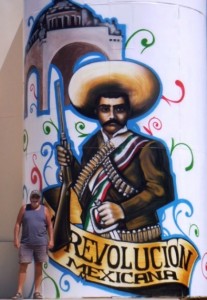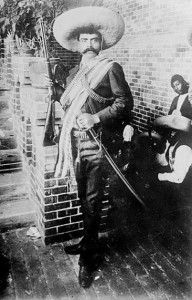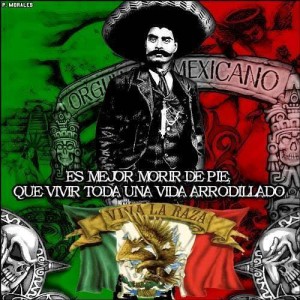
August 8th, 2012 – Born 142 years ago today, Emiliano Zapata Salazar (August 8, 1879 – April 10, 1919) was a leading figure in the Mexican Revolution, which broke out in 1910, and initially directed against the President Porfirio Díaz. Zapata was the son of a mestizo peasant who trained and sold horses. Orphaned at the age of 17, Zapata had to look after his younger brothers and sisters. In 1897 he was arrested for taking part in a protest by the peasants of his village against the hacienda that had appropriated their lands. Although he was pardoned, Zapata continued agitation among the peasants. He was drafted into the army and served for six months, at which point he was discharged to a landowner to train his horses. In 1909 his neighbours elected him president of the board of defense for their village. Negotiations with the landowners proved useless so Zapata and a group of peasants occupied the land that had been appropriated by the haciendas by force and distributed it among themselves.
Zapata supported the candidacy of Francisco I. Madero primarily because he believed Madero represented genuine change for land reform in Mexico. Zapata formed and commanded an important revolutionary force, the Liberation Army of the South (Ejército Libertador del Sur), during the Mexican Revolution. With the support of Pancho Villa, Pascual Orozco, Emiliano Zapata, and rebellious peasants, Madero overthrew Díaz in May 1911 in the battle at Ciudad Juárez and formed government. However, Zapata was dissatisfied with Madero’s stance on land reform and “ejidos”, and was unable, despite repeated efforts, to make him understand the importance of the issue or to get him to act on it. Madero and Zapata’s relations worsened during the summer of 1911 as Madero appointed a governor who supported plantation owners and refused to meet Zapata’s agrarian goals. Compromises between the two failed in November 1911, days after Madero appointed himself President, and Zapata fled to the mountains of southwest Puebla.
 Later Zapata mobilized his Liberation Army and allied with former Maderistas Pascual Orozco and Emiliano Vázquez Gómez. Orozco was from Chihuahua, near the U.S. border, and thus was able to aid the Zapatistas with a supply of arms. Zapata believed that the best route of attack would be to center the fighting and action in Cuautla. If this political location could be overthrown, the army would have enough power to “veto anyone else’s control of the state, negotiate for Cuernavaca or attack it directly, and maintain independent access to Mexico City as well as escape routes to the southern hills.”
Later Zapata mobilized his Liberation Army and allied with former Maderistas Pascual Orozco and Emiliano Vázquez Gómez. Orozco was from Chihuahua, near the U.S. border, and thus was able to aid the Zapatistas with a supply of arms. Zapata believed that the best route of attack would be to center the fighting and action in Cuautla. If this political location could be overthrown, the army would have enough power to “veto anyone else’s control of the state, negotiate for Cuernavaca or attack it directly, and maintain independent access to Mexico City as well as escape routes to the southern hills.”
Zapata was elected as “Supreme Chief of the Revolutionary Movement of the South”. Zapata immediately began to use his newly-found power and began to overthrow city after city with gaining momentum. Madero, alarmed, asked Zapata to disarm and demobilize. Zapata responded that, if the people could not win their rights now, when they were armed, they would have no chance once they were unarmed and helpless. Although the Treaty of Ciudad Juarez was too officially and formally ended the civil war, this was not reality. For Zapata the battle continued for years to come over the fact that Mexican individuals did not have agrarian rights that were fair, nor did they have the protection necessary to fight against those who pushed such exploitation upon them.

Although government forces could never completely defeat Zapata in battle, in 1919, he fell victim to a carefully staged ambush by military supporters of the then Mexican president, Venustiano Carranza. To make a military defection to Zapata’s forces appear sincere a Federal column was attacked killing 57 soldiers. On April 10, 1919 Zapata attended a meeting with these supposed army defectors. However, when Zapata arrived he was assassinated, riddled him with bullets. Following Zapata’s death, the Liberation Army of the South slowly fell apart, although Zapata’s heir apparent and many other Zapata adherents went on to political careers as representatives of Zapatista causes and positions in the Mexican army and government.
Zapata’s influence lasts to this day, particularly in revolutionary tendencies in south Mexico.


